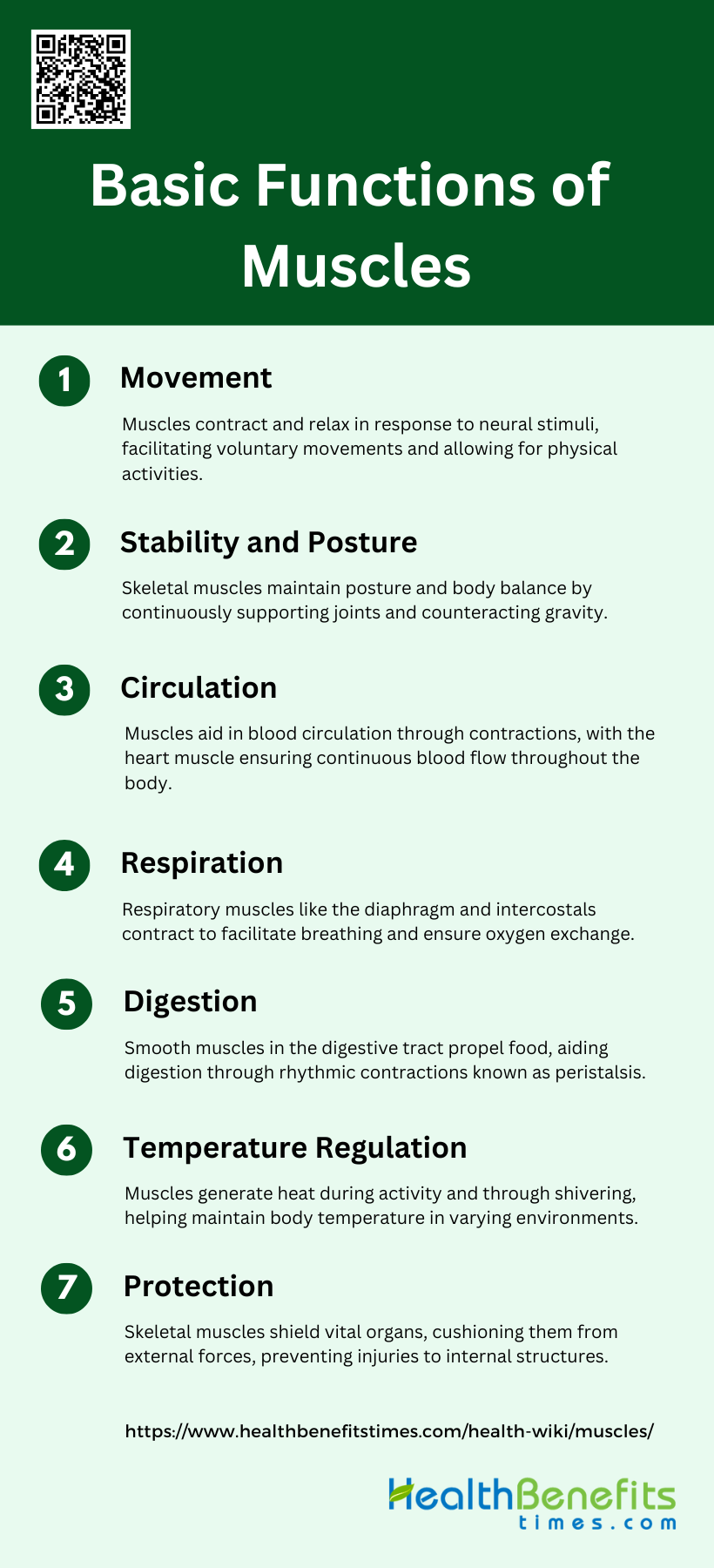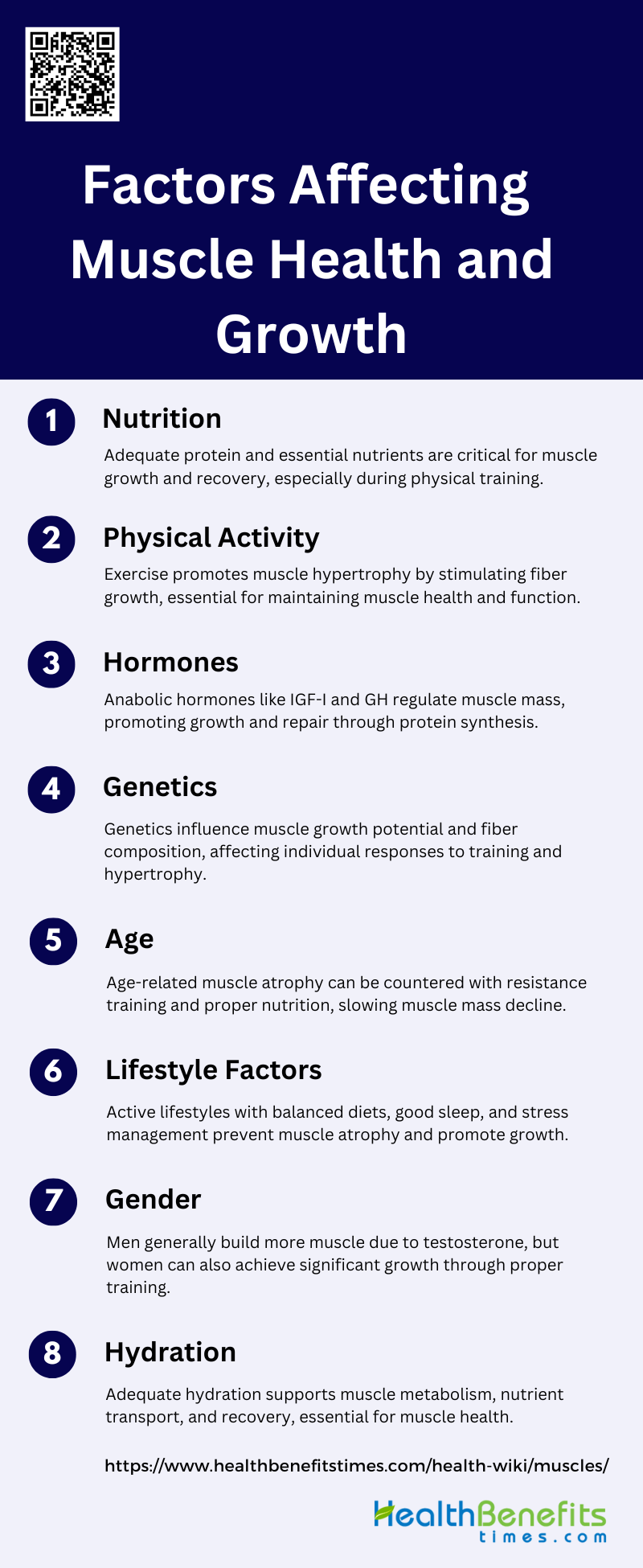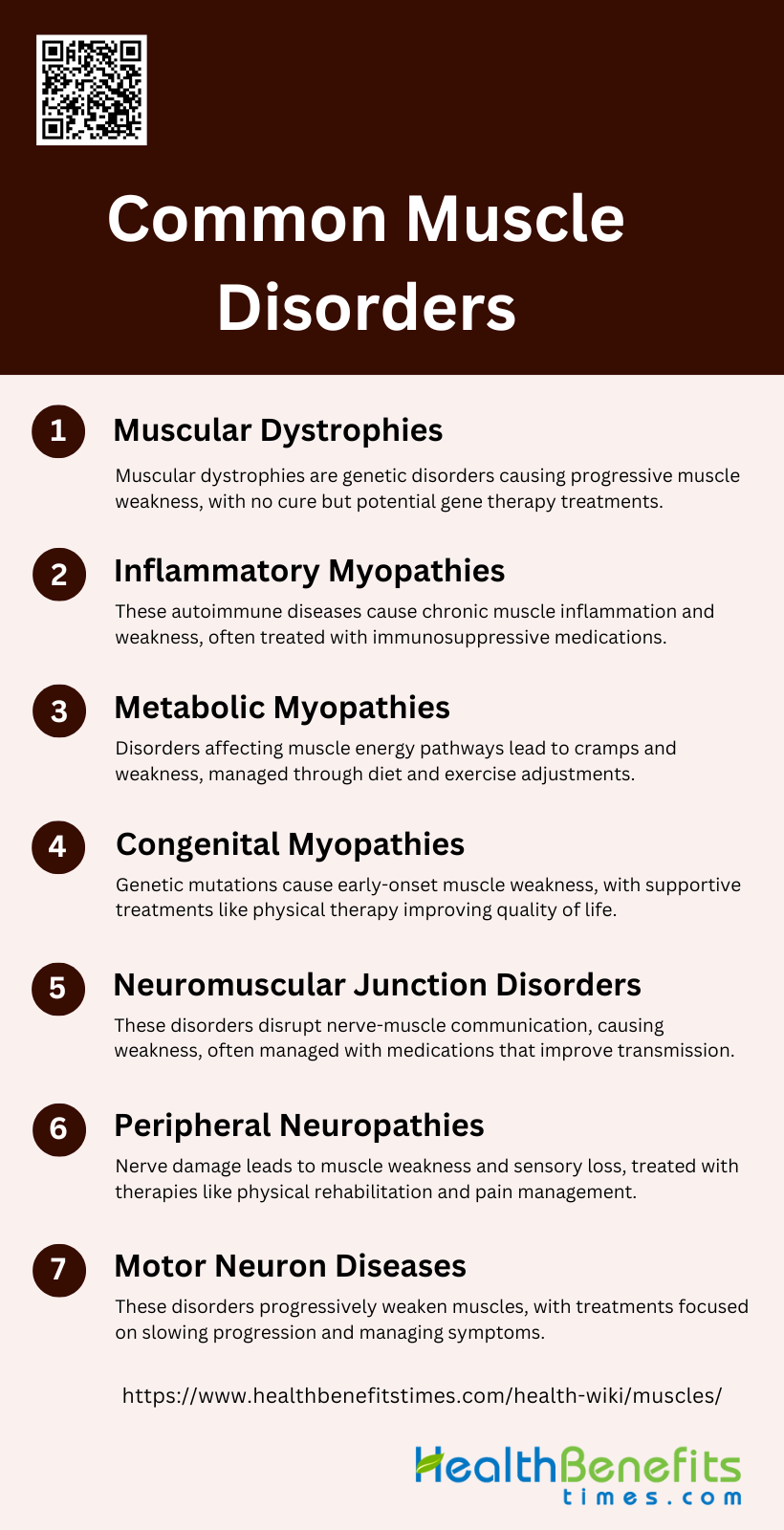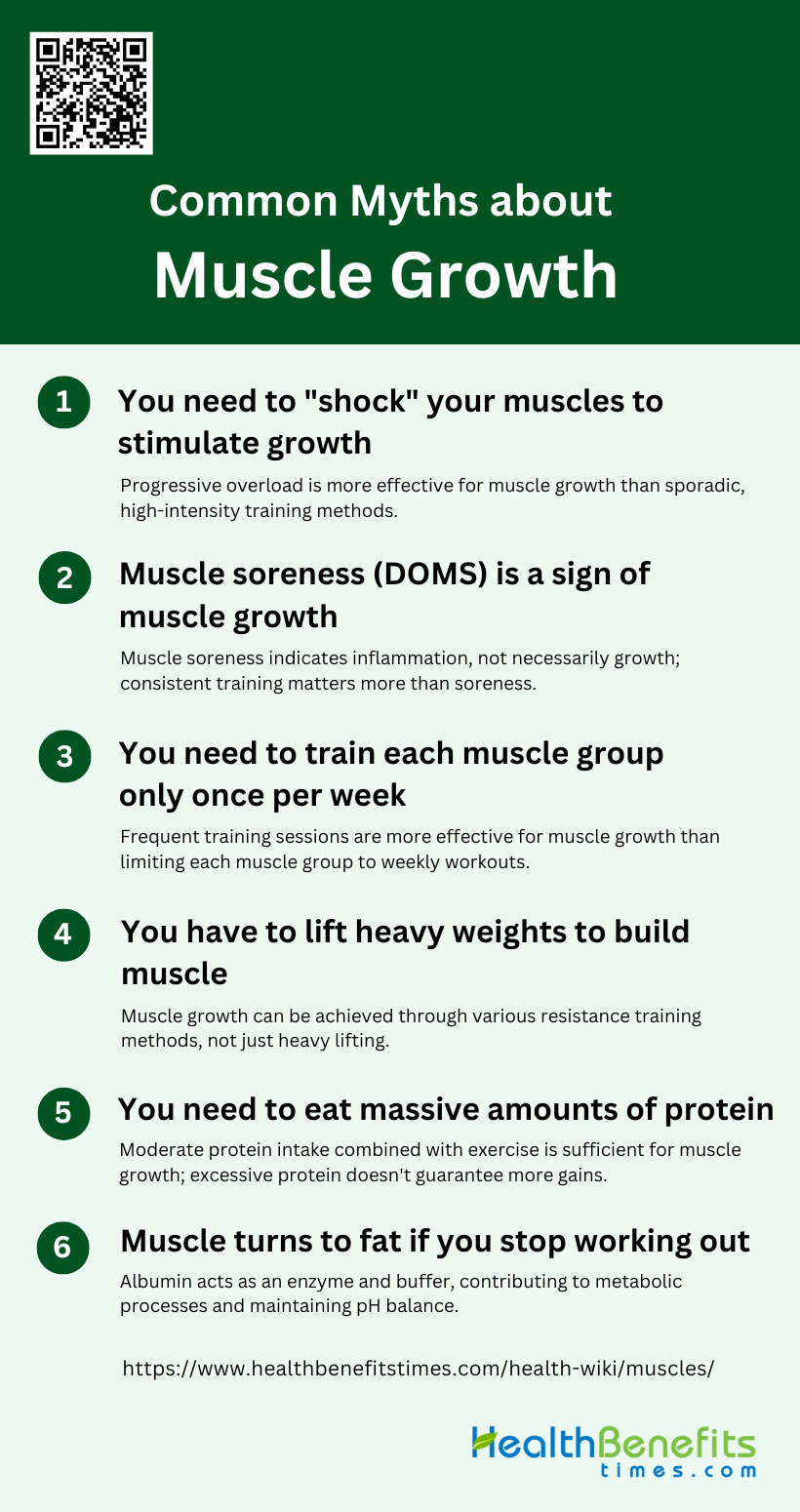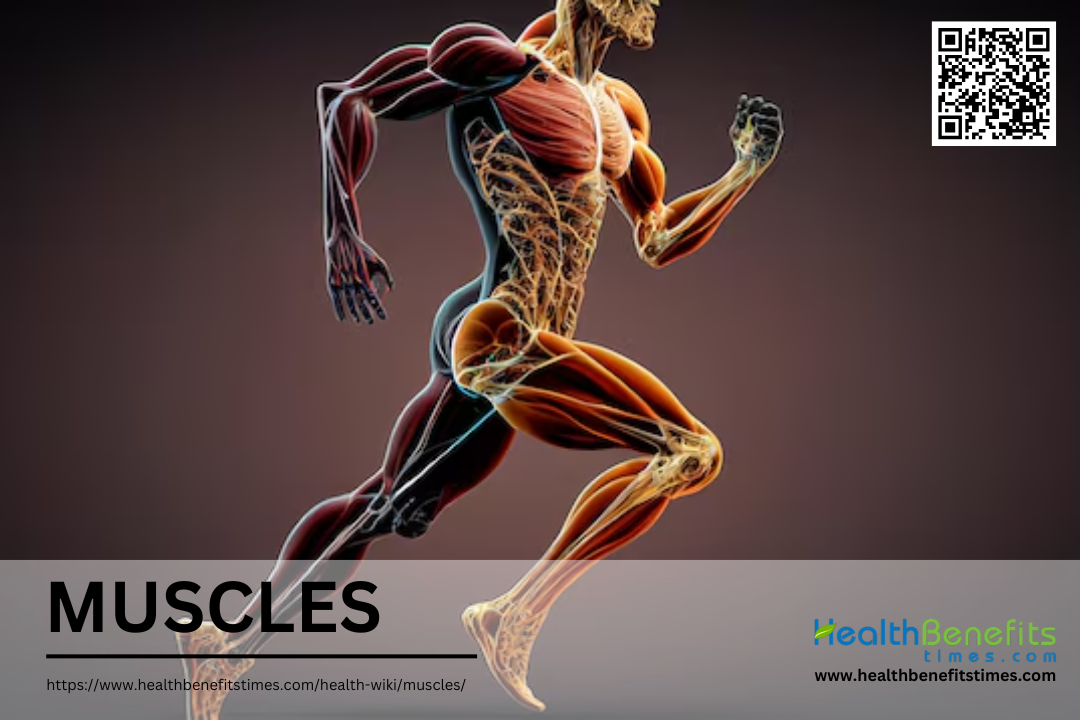 Muscles are specialized tissues in the body that are responsible for movement and force generation. They are composed of fibers that can contract and relax, allowing for various bodily functions such as locomotion, breathing, and maintaining posture. There are three main types of muscle tissue: skeletal, cardiac, and smooth. Skeletal muscles, which are attached to bones and are under voluntary control, consist of different fiber types that contribute to their specific functions and characteristics. These muscles work in coordination with the nervous system to produce precise movements and generate force. Muscles also play crucial roles in metabolism, heat production, and overall body shape. The composition and properties of muscles can be influenced by factors such as genetics, exercise, and certain medical conditions.
Muscles are specialized tissues in the body that are responsible for movement and force generation. They are composed of fibers that can contract and relax, allowing for various bodily functions such as locomotion, breathing, and maintaining posture. There are three main types of muscle tissue: skeletal, cardiac, and smooth. Skeletal muscles, which are attached to bones and are under voluntary control, consist of different fiber types that contribute to their specific functions and characteristics. These muscles work in coordination with the nervous system to produce precise movements and generate force. Muscles also play crucial roles in metabolism, heat production, and overall body shape. The composition and properties of muscles can be influenced by factors such as genetics, exercise, and certain medical conditions.
Types of Muscles
Muscles in the human body can be categorized into three main types: skeletal, smooth, and cardiac muscles. Each type has distinct characteristics, locations, and functions that are vital for various bodily processes. Below is a detailed description of each muscle type:
1. Skeletal Muscles
Skeletal muscles are characterized by their striated appearance due to the regular arrangement of sarcomeres, which are the contractile elements within the muscle fibers. These muscles are under voluntary control, meaning they contract in response to nerve impulses from the central nervous system. They are typically attached to bones via tendons and are responsible for locomotion and body movements. Examples of skeletal muscles include the biceps and quadriceps.
2. Smooth Muscles
Smooth muscles are non-striated and generally lighter in color compared to striated muscles. They are under involuntary control, meaning their contractions are regulated by hormones, external stimuli, and impulses from the autonomic nervous system. Smooth muscles are found in the walls of various organs and structures such as the digestive tract, blood vessels, bronchi, uterus, and bladder. They play a crucial role in controlling the size of lumens and generating peristaltic waves.
3. Cardiac Muscles
Cardiac muscles, also known as myocardium, are unique to the heart and are characterized by their striated appearance, similar to skeletal muscles. However, cardiac muscles are under involuntary control, contracting independently of conscious will. These muscles are essential for pumping blood through the circulatory system, maintaining blood circulation, and ensuring the heart functions effectively. The structural and metabolic identity of cardiac muscles is regulated by specific epigenetic mechanisms.
Composition of Muscles
Muscles are complex tissues composed of various elements that contribute to their function and performance. The primary components include muscle fibers, connective tissue, and essential proteins. Below is composition of muscles:
1. Muscle Fibers
Muscle fibers are categorized into two main types: Type I (slow-twitch) and Type II (fast-twitch). Type I fibers are rich in mitochondria and rely on oxidative metabolism, making them more resistant to fatigue and suitable for endurance activities. Type II fibers, on the other hand, are adapted for quick, powerful contractions and rely more on glycolytic metabolism, making them ideal for short bursts of activity. The proportion of these fibers can be influenced by genetic factors and physical training.
2. Connective Tissue
Connective tissues, including tendons and ligaments, play a crucial role in muscle function by transmitting the force generated by muscle contractions to bones, enabling movement. Fascia, a type of connective tissue, surrounds muscles, providing structural support and reducing friction between muscle groups during movement. This connective network is essential for maintaining muscle integrity and function, especially during physical activities.
3. Proteins in Muscles
Key proteins involved in muscle contraction include actin and myosin, which form the contractile filaments within muscle fibers. These proteins interact within myofibrils, the basic rod-like units of a muscle cell, to produce muscle contractions. Myofibrils are critical for muscle strength and endurance, as they house the machinery necessary for muscle contraction and force generation. The regulation of these proteins and their interactions is essential for muscle performance and adaptation to different physical demands.
Basic functions of muscles
Muscles are vital for numerous bodily functions, ranging from movement to maintaining homeostasis. They work in coordination with various systems to ensure the body operates efficiently. Below are the primary functions of muscles:
1. Movement
Muscles are essential for movement, enabling the body to perform a wide range of activities from simple gestures to complex athletic maneuvers. Skeletal muscles, in particular, are responsible for voluntary movements by contracting and relaxing in response to neural stimuli. This contraction and relaxation process allows for the manipulation of bones and joints, facilitating locomotion and other physical activities. The intricate coordination of muscle fibers ensures smooth and precise movements, which are vital for daily tasks and overall physical fitness.
2. Stability and Posture
Muscles play a crucial role in maintaining stability and posture. Skeletal muscles, especially those in the core and back, provide the necessary support to keep the body upright and balanced. These muscles work continuously, even when we are not actively moving, to counteract the force of gravity and stabilize the spine and other joints. Proper muscle function is essential for maintaining an upright posture and preventing falls and injuries. Muscle strength and endurance are key factors in sustaining good posture and overall body alignment.
3. Circulation
Muscles significantly contribute to the circulatory system by aiding in the movement of blood throughout the body. During muscle contractions, blood vessels within the muscles are compressed, which helps propel blood back to the heart. This process, known as the muscle pump, is particularly important in the lower extremities, where it assists in overcoming the effects of gravity. Additionally, the heart itself is a muscle, and its rhythmic contractions are essential for maintaining blood circulation and ensuring that oxygen and nutrients are delivered to tissues while waste products are removed.
4. Respiration
Muscles are vital for respiration, the process of breathing. The diaphragm, a dome-shaped muscle located below the lungs, plays a primary role in inhalation by contracting and creating a vacuum that allows air to enter the lungs. Intercostal muscles, located between the ribs, assist in expanding and contracting the chest cavity during breathing. These respiratory muscles work together to facilitate the exchange of oxygen and carbon dioxide, which is essential for cellular respiration and overall metabolic function.
5. Digestion
Muscles are integral to the digestive process, facilitating the movement of food through the gastrointestinal tract. Smooth muscles in the walls of the digestive organs contract rhythmically in a process known as peristalsis, which propels food from the esophagus to the stomach and through the intestines. This coordinated muscle activity ensures that food is mixed with digestive enzymes and broken down into absorbable nutrients. Proper muscle function in the digestive system is crucial for efficient digestion and nutrient absorption.
6. Temperature Regulation
Muscles play a key role in regulating body temperature through thermogenesis. During physical activity, muscle contractions generate heat as a byproduct of energy metabolism. This heat production helps maintain body temperature, especially in cold environments. Additionally, shivering, an involuntary muscle contraction, is a mechanism the body uses to generate heat when exposed to cold temperatures. The ability of muscles to produce heat is essential for maintaining homeostasis and ensuring the proper functioning of enzymatic and metabolic processes.
7. Protection
Muscles provide protection to vital organs and structures within the body. Skeletal muscles form a protective layer around bones and internal organs, cushioning them from external impacts and reducing the risk of injury. For example, abdominal muscles protect the intestines, liver, and other organs in the abdominal cavity, while muscles around the rib cage shield the heart and lungs. This protective function is crucial for maintaining the integrity of the body’s internal systems and ensuring overall health and safety.
How Muscles Develop
Muscle development is a complex process influenced by various factors such as exercise, nutrition, and age. Understanding how muscles grow, repair, and change over time is essential for optimizing physical performance and overall health. Below are the key aspects of muscle development:
1. Muscle Growth and Hypertrophy
Muscle hypertrophy, the enlargement of muscle fibers, is primarily driven by resistance training, which stimulates protein synthesis and ribosomal biogenesis, essential for muscle growth. The mTORC1 pathway plays a central role in regulating protein synthesis and ribosomal biogenesis, while satellite cells contribute to muscle growth by increasing myonuclei content. Additionally, dietary protein intake and adequate rest are crucial for supporting muscle protein synthesis and recovery, enhancing the hypertrophic response to resistance training.
2. Muscle Repair and Regeneration
Muscle repair and regeneration involve the activation of satellite cells, which proliferate and differentiate into myofibers to repair damaged muscle tissue. Protein synthesis is vital for muscle recovery, with insulin-like growth factors (IGFs) playing a key role in promoting both muscle cell proliferation and differentiation. The initial phase of resistance training focuses on muscle damage repair, while subsequent phases contribute to hypertrophy as muscle damage attenuates. Satellite cells are indispensable for muscle repair, although their role in hypertrophy can vary depending on the context.
3. Age-Related Muscle Development
Muscle mass and strength typically peak in early adulthood and decline with age, a process known as sarcopenia. Aging leads to a reduction in muscle fiber size and number, decreased satellite cell activity, and impaired protein synthesis, contributing to muscle atrophy. Resistance training and increased IGF-I expression can mitigate age-related muscle loss by promoting muscle hypertrophy and enhancing muscle repair mechanisms. However, the regenerative capacity of muscles diminishes with age, making it crucial to maintain an active lifestyle to preserve muscle function.
Factors Affecting Muscle Health and Growth
Muscle health and growth are influenced by a variety of factors that work together to optimize physical performance and overall well-being. Understanding these factors can help individuals make informed decisions to enhance their muscle development and maintain a healthy lifestyle. Below are the key factors that play a crucial role in muscle health and growth:
1. Nutrition
Nutrition plays a critical role in muscle health and growth. Adequate intake of proteins, amino acids, and essential nutrients is necessary for muscle protein synthesis and hypertrophy. Nutritional interventions, such as supplementation with amino acids, creatine, and β-hydroxy-β-methyl butyrate, have been shown to significantly improve muscle mass, especially in older adults. Additionally, maternal nutrition can impact embryonic muscle progenitor cells, influencing both prenatal and postnatal muscle development. Therefore, a balanced diet rich in essential nutrients is crucial for optimal muscle growth and maintenance.
2. Physical Activity
Physical activity is a key determinant of muscle growth and health. Exercise stimulates muscle hypertrophy by increasing muscle fiber diameter and length through the addition of myofibrils and sarcomeres. Regular physical activity, combined with nutritional supplementation, has been shown to increase fat-free mass, strength, and overall functionality in the elderly. The mechanical stress from exercise induces muscle adaptation, promoting protein synthesis and muscle fiber growth, which are essential for maintaining muscle health and preventing atrophy.
3. Hormones
Hormones significantly influence muscle mass and growth. Anabolic hormones like insulin-like growth factor (IGF)-I and growth hormone (GH) stimulate muscle protein synthesis and hypertrophy. These hormones act through signaling pathways involving protein kinase B (Akt), which integrates anabolic and catabolic responses to regulate muscle mass. Declining levels of these hormones with age contribute to muscle atrophy, but local production within muscle tissue can still promote growth and repair. Hormonal balance is thus essential for maintaining muscle health.
4. Genetics
Genetics fundamentally determine the potential for muscle size and growth. Genetic factors influence the number of muscle fibers an individual is born with and their capacity for hypertrophy. Variations in genes related to muscle growth factors, such as myostatin, can significantly impact muscle mass and strength. Understanding the genetic basis of muscle growth can help identify individuals at risk of muscle-related conditions and tailor interventions to enhance muscle health based on genetic predispositions.
5. Age
Age is a critical factor affecting muscle health and growth. Muscle mass and strength typically decline with age due to reduced anabolic hormone levels and decreased physical activity. Older muscles are less capable of repairing damage and adapting to mechanical stress, leading to atrophy. However, strength training and nutritional interventions can mitigate age-related muscle loss, demonstrating that older adults retain the ability to increase muscle mass and strength through appropriate exercise and diet.
6. Lifestyle Factors
Lifestyle factors, including physical activity levels, diet, and overall health habits, play a significant role in muscle health. Sedentary lifestyles and poor dietary choices can lead to muscle atrophy and weakness, while active lifestyles and balanced diets promote muscle growth and maintenance. Additionally, factors such as sleep quality, stress management, and avoiding harmful behaviors like smoking and excessive alcohol consumption are crucial for maintaining muscle health and preventing muscle-related diseases.
7. Gender
Gender differences influence muscle health and growth due to variations in hormone levels and muscle fiber composition. Men generally have higher levels of anabolic hormones like testosterone, which promotes greater muscle mass and strength compared to women. However, women can still achieve significant muscle growth and strength gains through resistance training and proper nutrition. Understanding these gender differences is important for designing effective muscle health interventions tailored to each gender’s unique physiological characteristics.
8. Hydration
Hydration is essential for muscle function and growth. Adequate water intake supports muscle metabolism, nutrient transport, and waste removal, all of which are critical for muscle health. Dehydration can impair muscle performance, reduce strength, and increase the risk of muscle cramps and injuries. Ensuring proper hydration, especially during and after exercise, helps maintain muscle function and supports recovery and growth processes. Therefore, maintaining optimal hydration levels is crucial for sustaining muscle health and promoting growth.
Common Muscle Disorders
Muscle disorders encompass a wide range of conditions that affect muscle function and health, leading to symptoms such as weakness, pain, and reduced mobility. Understanding these disorders is crucial for early diagnosis and effective management. Below are some of the most common muscle disorders:
1. Muscular Dystrophies
Muscular dystrophies are a group of over 160 neuromuscular disorders characterized by progressive muscle weakness and degeneration. These disorders vary widely in terms of age of onset, severity, and progression. The most well-known types include Duchenne muscular dystrophy and Becker muscular dystrophy, both caused by mutations in the dystrophin gene. Despite significant advances in understanding the genetic basis of these diseases, there are currently no cures, although gene therapy shows promise for future treatments.
2. Inflammatory Myopathies
Inflammatory myopathies are a group of diseases characterized by chronic muscle inflammation and weakness. The most common types include polymyositis, dermatomyositis, and inclusion body myositis. These conditions are often associated with autoimmune responses, where the body’s immune system mistakenly attacks its own muscle tissue. Diagnosis typically involves muscle biopsy, blood tests for muscle enzymes, and imaging studies. Treatment usually includes immunosuppressive medications to reduce inflammation and improve muscle strength.
3. Metabolic Myopathies
Metabolic myopathies are a group of disorders caused by defects in the biochemical pathways that produce energy in muscle cells. These include glycogen storage diseases like McArdle’s disease and lipid storage disorders. Symptoms often include muscle cramps, weakness, and exercise intolerance. Diagnosis is typically made through genetic testing, muscle biopsy, and biochemical assays. Management focuses on dietary modifications and avoiding strenuous exercise to prevent muscle damage.
4. Congenital Myopathies
Congenital myopathies are early-onset, non-dystrophic muscle disorders characterized by specific structural abnormalities in muscle fibers. Common types include central core disease, nemaline myopathy, and centronuclear myopathy. These conditions are usually present at birth and result from genetic mutations affecting muscle proteins. Symptoms range from mild muscle weakness to severe respiratory issues. While there are no cures, supportive treatments such as physical therapy and respiratory support can improve quality of life.
5. Neuromuscular Junction Disorders
Neuromuscular junction disorders affect the synapse between motor neurons and muscle fibers, impairing muscle contraction. The most common conditions are myasthenia gravis and Lambert-Eaton myasthenic syndrome. These disorders are often autoimmune in nature, where antibodies disrupt the communication between nerves and muscles. Symptoms include muscle weakness and fatigue, which can be managed with medications that enhance neuromuscular transmission and immunosuppressants.
6. Peripheral Neuropathies
Peripheral neuropathies involve damage to the peripheral nerves, leading to muscle weakness, sensory loss, and autonomic dysfunction. Charcot-Marie-Tooth disease is one of the most common inherited peripheral neuropathies. These conditions can result from genetic mutations, metabolic disorders, or autoimmune diseases. Diagnosis often involves nerve conduction studies, genetic testing, and nerve biopsy. Treatment focuses on managing symptoms and may include physical therapy, pain management, and orthotic devices.
7. Motor Neuron Diseases
Motor neuron diseases are a group of progressive neurological disorders that affect motor neurons, leading to muscle weakness and atrophy. Amyotrophic lateral sclerosis (ALS) is the most well-known type, characterized by the degeneration of both upper and lower motor neurons. Symptoms include muscle weakness, spasticity, and difficulty speaking or swallowing. There is no cure, but treatments such as riluzole and edaravone can slow disease progression and improve quality of life.
Common Myths about Muscle Growth
There are many misconceptions about muscle growth that can mislead individuals trying to build muscle effectively. Understanding the truth behind these myths can help optimize your training and nutrition strategies. Below are some common myths about muscle growth:
1. You need to “shock” your muscles to stimulate growth
The idea that muscles need to be “shocked” to stimulate growth is a common myth. Research indicates that consistent, progressive overload is more effective for muscle hypertrophy than sporadic, high-intensity shocks. For instance, a study on carbohydrate availability and training adaptations found that consistent training, regardless of carbohydrate intake, led to significant improvements in muscle oxidative enzyme activity and heat shock protein content, without the need for extreme or shocking methods. This suggests that regular, structured training is sufficient for muscle growth.
2. Muscle soreness (DOMS) is a sign of muscle growth
Delayed-onset muscle soreness (DOMS) is often mistaken as an indicator of muscle growth, but this is not necessarily true. DOMS is primarily a result of microtrauma to muscle fibers and the subsequent inflammatory response. Research has shown that DOMS involves the activation of pathways like Hsp70/TLR4/IL-6 and TNF-α, which are related to inflammation rather than muscle hypertrophy. Therefore, while DOMS can accompany muscle growth, it is not a reliable indicator of it.
3. You need to train each muscle group only once per week
Training each muscle group only once per week is another myth. Studies have demonstrated that more frequent training can lead to better muscle hypertrophy and strength gains. For example, a study on resistance training in older adults showed significant improvements in muscle mass and function with thrice-weekly sessions. This suggests that higher frequency training can be more effective for muscle growth than the traditional once-a-week approach.
4. You have to lift heavy weights to build muscle
While lifting heavy weights can contribute to muscle growth, it is not the only way to achieve hypertrophy. Research has shown that resistance training using bodyweight and elastic bands can also lead to significant muscle gains, especially when combined with protein supplementation. This indicates that muscle growth can be achieved through various forms of resistance training, not just heavy lifting.
5. You need to eat massive amounts of protein
The belief that massive amounts of protein are necessary for muscle growth is exaggerated. While protein is essential for muscle repair and growth, excessive intake does not necessarily translate to greater muscle gains. A study on protein supplementation and resistance training in older adults found that moderate protein intake, combined with regular exercise, was sufficient to improve muscle mass and function. Thus, a balanced diet with adequate protein is more beneficial than consuming excessive amounts.
6. Muscle turns to fat if you stop working out
Muscle does not turn into fat if you stop working out; they are two distinct tissues. When you stop exercising, muscle mass may decrease due to atrophy, and if caloric intake remains high, fat accumulation can occur. However, these processes are independent. Research on muscle atrophy and recovery has shown that muscle loss can be mitigated through interventions like cyclic compressive loading, which helps maintain muscle integrity even during periods of inactivity. Therefore, muscle and fat are separate entities, and one does not transform into the other.
FAQs
1. How do muscles adapt to different types of exercises?
Muscles adapt to different types of exercises through a process called muscle plasticity. Resistance training increases muscle size and strength through hypertrophy, while endurance exercises improve muscle oxidative capacity and stamina by enhancing mitochondrial density and blood supply to the muscles.
2. What role does sleep play in muscle growth?
Sleep is crucial for muscle recovery and growth as it is during deep sleep that the body releases growth hormones, which aid in muscle repair and protein synthesis. Lack of adequate sleep can hinder muscle recovery, leading to decreased performance and slower gains.
3. Can muscle health affect mental well-being?
Yes, regular muscle activity, particularly through exercise, releases endorphins and other neurotransmitters that improve mood, reduce stress, and enhance overall mental well-being. Maintaining muscle health also supports better posture and physical confidence, which can positively influence mental health.
4. How does aging affect muscle recovery time?
As people age, muscle recovery time increases due to a decline in the body’s ability to repair and regenerate muscle tissue. Reduced levels of growth hormones, decreased satellite cell activity, and a slower rate of protein synthesis all contribute to slower recovery in older adults.
5. What is the difference between muscle endurance and muscle strength?
Muscle endurance is the ability of a muscle to sustain prolonged activity, such as running or cycling, while muscle strength refers to the maximum force a muscle can produce in a single effort, like lifting a heavy weight. Both can be trained, but they require different exercise approaches.
6. How does muscle mass impact metabolism?
Muscle mass directly influences metabolism because muscles require more energy to maintain than fat. Therefore, individuals with more muscle mass have a higher resting metabolic rate, meaning they burn more calories even when at rest.
7. Can muscle imbalances lead to injury?
Yes, muscle imbalances occur when opposing muscle groups are not equally developed, which can lead to poor posture, joint stress, and a higher risk of injury. Balanced strength training that targets all muscle groups can help prevent such imbalances.
8. How does dehydration affect muscle performance?
Dehydration can reduce muscle performance by impairing the delivery of nutrients and oxygen to muscle tissue, leading to early fatigue, cramps, and reduced strength during exercise. Proper hydration is essential for muscle function and endurance.
9. Can genetics limit muscle growth potential?
Yes, genetics play a significant role in determining muscle fiber composition and the capacity for muscle growth. Some individuals are genetically predisposed to have a higher proportion of fast-twitch fibers, which may allow for greater muscle hypertrophy, while others may have more slow-twitch fibers, which enhance endurance.
10. How does poor posture affect muscle health?
Poor posture can lead to muscle imbalances and overstrain certain muscles, causing discomfort, pain, and long-term issues like back problems. Strengthening postural muscles and maintaining good alignment can prevent these problems and improve overall muscle health.


